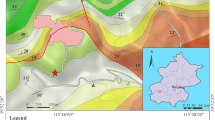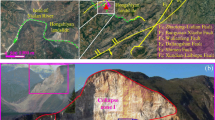Abstract
The depth-integrated model has been applied to the simulation of various kinds of earth surface flows. However, there are few studies that focus on the difference between the associated dynamic processes and the computational results. The recent Daanshan Village rockslide, recorded by 3 real-time videos from different view angles as well as pre-slide images and detailed field investigations, offers an opportunity to provide some new insights into this issue. In this paper, the failure mechanism and dynamic processes behind the Daanshan rockslide were analyzed in detail and simulation results obtained from depth-integrated modeling in both the vertical and rotated coordinate systems were compared with the videos and field investigations. The field investigations reveal that the rockslide was essentially controlled by the sedimentary unconformity interface and the interbedded black mudstone layers, and triggered by intense rainfall. The comparisons indicate that the simulated trimlines generally matched the real trimlines at each second, but at the initial stage, the simulated velocities are a little large. With respect to the final deposition area, the simulated runout distance and trimlines matched well with the field investigation results, and the accuracy estimated by the contact area percentage of the maximum impact area reached 91.46%. The simulation results obtained from the vertical and rotated coordinate systems show significant differences. The simulation accuracy of the rotated coordinate system was 91.46%, while for the vertical coordinate system it was 84.69%, demonstrating that the rotated coordinate system should be used, or the vertical acceleration should be modified to obtain credible results. This comprehensive analysis verified that the depth-integrated model can access both rockslide processes and the final deposition area. It is pointed out that the rotated coordinate system can obtain better results than the vertical coordinate system in areas with steep slopes, whereas the differences can be neglected when considering gentle slopes.













Similar content being viewed by others
References
Angeli M-G, Pasuto A, Silvano S (2000) A critical review of landslide monitoring experiences. Eng Geol 55:133–147. https://doi.org/10.1016/S0013-7952(99)00122-2
Castro-Orgaz O, Hutter K, Giraldez JV, Hager WH (2015) Nonhydrostatic granular flow over 3-D terrain: new Boussinesq-type gravity waves? J Geophys Res Earth Surf 120:1–28. https://doi.org/10.1002/2014JF003279
Dai K, Xu Q, Li Z, Tomás R, Fan X, Dong X, Li W, Zhou Z, Gou J, Ran P (2019) Post-disaster assessment of 2017 catastrophic Xinmo landslide (China) by spaceborne SAR interferometry. Landslides. 16:1189–1199. https://doi.org/10.1007/s10346-019-01152-4
Denlinger RP, Iverson RM (2004) Granular avalanches across irregular three-dimensional terrain: 1. Theory and computation. J Geophys Res-Earth Surf 109:F01014. https://doi.org/10.1029/2003JF000085
Evans SG, Guthrie RH, Roberts NJ, Bishop NF (2007) The disastrous 17 February 2006 rockslide-debris avalanche on Leyte Island, Philippines: a catastrophic landslide in tropical mountain terrain. Nat Hazards Earth Syst Sci 7:89–101. https://doi.org/10.5194/nhess-7-89-2007
Fan X, Xu Q, Scaringi G et al (2017) Failure mechanism and kinematics of the deadly June 24th 2017 Xinmo landslide, Maoxian, Sichuan, China. Landslides 14:2129–2146. https://doi.org/10.1007/s10346-017-0907-7
Goren L, Aharonov E (2007) Long runout landslides: the role of frictional heating and hydraulic diffusivity. Geophys Res Lett. 34. https://doi.org/10.1029/2006GL028895
Goren L, Aharonov E (2009) On the stability of landslides: a thermo-poro-elastic approach. Earth Planet Sci Lett 277:365–372. https://doi.org/10.1016/j.epsl.2008.11.002
Guthrie RH, Evans SG, Catane SG, Zarco MAH, Saturay RM Jr (2009) The 17 February 2006 rock slide-debris avalanche at Guinsaugon Philippines: a synthesis. Bull Eng Geol Environ 68:201–213. https://doi.org/10.1007/s10064-009-0205-2
Hearn GJ (2019) Geomorphology in engineering geological mapping and modelling. Bull Eng Geol Environ 78:723–742. https://doi.org/10.1007/s10064-017-1166-5
Hu K, Wu C, Tang J, Pasuto A, Li Y, Yan S (2018) New understandings of the June 24th 2017 Xinmo Landslide, Maoxian, Sichuan, China. Landslides 15:2465–2474. https://doi.org/10.1007/s10346-018-1073-2
Iverson RM, George DL (2015) Modelling landslide liquefaction, mobility bifurcation and the dynamics of the 2014 Oso disaster. Géotechnique 66:175–187. https://doi.org/10.1680/jgeot.15.LM.004
Iverson RM, Ouyang C (2015) Entrainment of bed material by earth-surface mass flows. Rev Geophys 53:27–58. https://doi.org/10.1002/2013RG000447
Labuz JF, Zang A (2012) Mohr–coulomb failure criterion. Rock Mech Rock Eng 45:975–979. https://doi.org/10.1007/s00603-012-0281-7
Liang D, Falconer RA, Lin B (2006) Comparison between TVD-MacCormack and ADI-type solvers of the shallow water equations. Adv Water Resour 29:1833–1845. https://doi.org/10.1016/j.advwatres.2006.01.005
Liang G, Wang Z, Zhang G, Wu L (2019) Two huge landslides that took place in quick succession within a month at the same location of Jinsha River. Landslides 16:1059–1062. https://doi.org/10.1007/s10346-019-01165-z
Lin C-H, Lin M-L (2015) Evolution of the large landslide induced by Typhoon Morakot: a case study in the Butangbunasi River, southern Taiwan using the discrete element method. Eng Geol 197:172–187. https://doi.org/10.1016/j.enggeo.2015.08.022
Lo C-M, Huang W-K, Lin M-L (2016) Earthquake-induced deep-seated landslide and landscape evolution process at Hungtsaiping, Nantou County, Taiwan. Environ Earth Sci 75:645–616. https://doi.org/10.1007/s12665-016-5474-z
Lucas A, Mangeney A, Ampuero JP (2014) Frictional velocity-weakening in landslides on earth and on other planetary bodies. Nat Commun 5:3417. https://doi.org/10.1038/ncomms4417
McDougall S (2016) 2014 Canadian Geotechnical Colloquium: landslide runout analysis — current practice and challenges. Can Geotech J 54:605–620. https://doi.org/10.1139/cgj-2016-0104
McDougall S, Hungr O (2005) Dynamic modelling of entrainment in rapid landslides. Can Geotech J 42:1437–1448. https://doi.org/10.1139/T05-064
Ochiai H, Okada Y, Furuya G et al (2004) A fluidized landslide on a natural slope by artificial rainfall. Landslides 1:211–219. https://doi.org/10.1007/s10346-004-0030-4
Ouyang C, He S, Xu Q et al (2013) A MacCormack-TVD finite difference method to simulate the mass flow in mountainous terrain with variable computational domain. Comput Geosci 52:1–10. https://doi.org/10.1016/j.cageo.2012.08.024
Ouyang C, He S, Tang C (2015) Numerical analysis of dynamics of debris flow over erodible beds in Wenchuan earthquake-induced area. Eng Geol 194:62–72. https://doi.org/10.1016/j.enggeo.2014.07.012
Ouyang C, Zhao W, He S et al (2017a) Numerical modeling and dynamic analysis of the 2017 Xinmo landslide in Maoxian County, China. J Mt Sci 14:1701–1711. https://doi.org/10.1007/s11629-017-4613-7
Ouyang C, Zhou K, Xu Q et al (2017b) Dynamic analysis and numerical modeling of the 2015 catastrophic landslide of the construction waste landfill at Guangming, Shenzhen, China. Landslides 14:705–718. https://doi.org/10.1007/s10346-016-0764-9
Ouyang C, Zhao W, Xu Q, Peng D, Li W, Wang D, Zhou S, Hou S (2018) Failure mechanisms and characteristics of the 2016 catastrophic rockslide at Su village, Lishui, China. Landslides 15:1391–1400. https://doi.org/10.1007/s10346-018-0985-1
Ouyang C, An H, Zhou S, Wang Z, Su P, Wang D, Cheng D, She J (2019) Insights from the failure and dynamic characteristics of two sequential landslides at Baige village along the Jinsha River, China. Landslides 16:1397–1414. https://doi.org/10.1007/s10346-019-01177-9
Pastor M, Blanc T, Haddad B, Drempetic V, Morles MS, Dutto P, Stickle MM, Mira P, Merodo JAF (2015) Depth averaged models for fast landslide propagation: mathematical, rheological and numerical aspects. Arch Computat Methods Eng 22:67–104. https://doi.org/10.1007/s11831-014-9110-3
Petley D (2012) Global patterns of loss of life from landslides. Geology 40:927–930. https://doi.org/10.1130/G33217.1
Sartori M, Baillifard F, Jaboyedoff M, Rouiller J-D (2003) Kinematics of the 1991 Randa rockslides (Valais, Switzerland). Nat Hazards Earth Syst Sci 3:423–433. https://doi.org/10.5194/nhess-3-423-2003
Savage SB, Hutter K (1989) The motion of a finite mass of granular material down a rough incline. J Fluid Mech 199:177–215. https://doi.org/10.1017/S0022112089000340
Soga K, Alonso E, Yerro A et al (2016) Trends in large-deformation analysis of landslide mass movements with particular emphasis on the material point method. Géotechnique 66:248–273. https://doi.org/10.1680/jgeot.15.LM.005
Su L, Hu K, Zhang W et al (2017) Characteristics and triggering mechanism of Xinmo landslide on 24 June 2017 in Sichuan, China. J Mt Sci 14:1689–1700. https://doi.org/10.1007/s11629-017-4609-3
Xing A, Wang G, Li B et al (2014) Long-runout mechanism and landsliding behaviour of large catastrophic landslide triggered by heavy rainfall in Guanling, Guizhou, China. Can Geotech J 52:971–981. https://doi.org/10.1139/cgj-2014-0122
Xu Q, Fan X, Huang R et al (2010) A catastrophic rockslide-debris flow in Wulong, Chongqing, China in 2009: background, characterization, and causes. Landslides 7:75–87. https://doi.org/10.1007/s10346-009-0179-y
Yan Y, Cui P, Guo X, Ge Y (2016) Trace projection transformation: a new method for measurement of debris flow surface velocity fields. Front Earth Sci 10:761–771. https://doi.org/10.1007/s11707-015-0576-6
Yin Y, Wang F, Sun P (2009) Landslide hazards triggered by the 2008 Wenchuan earthquake, Sichuan, China. Landslides 6:139–152. https://doi.org/10.1007/s10346-009-0148-5
Yin Y, Sun P, Zhu J, Yang S (2011) Research on catastrophic rock avalanche at Guanling, Guizhou, China. Landslides 8:517–525. https://doi.org/10.1007/s10346-011-0266-8
Zhang LL, Zhang J, Zhang LM, Tang WH (2011) Stability analysis of rainfall-induced slope failure: a review. Proc Inst Civil Eng-Geotech Eng 164:299–316. https://doi.org/10.1680/geng.2011.164.5.299
Zhang Z, He S, Liu W, Liang H, Yan S, Deng Y, Bai X, Chen Z (2019) Source characteristics and dynamics of the October 2018 Baige landslide revealed by broadband seismograms. Landslides 16:777–785. https://doi.org/10.1007/s10346-019-01145-3
Zhao L, Zuo S, Deng D, Han Z, Zhao B (2018a) Development mechanism for the landslide at Xinlu Village, Chongqing, China. Landslides 15:2075–2081. https://doi.org/10.1007/s10346-018-1051-8
Zhao S, Chigira M, Wu X (2018b) Buckling deformations at the 2017 Xinmo landslide site and nearby slopes, Maoxian, Sichuan, China. Eng Geol 246:187–197. https://doi.org/10.1016/j.enggeo.2018.09.033
Zhao L, Li D, Tan H, Cheng X, Zuo S (2019) Characteristics of failure area and failure mechanism of a bedding rockslide in Libo County, Guizhou, China. Landslides 16:1367–1374. https://doi.org/10.1007/s10346-019-01188-6
Funding
Financial support was provided by the National Key Research and Development Program of China (Project No. 2017YFC1501000), the Strategic Priority Research Program of CAS (Grant No. XDA23090303), the NSFC (Grant No. 41572303), and the CAS Youth Innovation Promotion Association.
Author information
Authors and Affiliations
Corresponding author
Rights and permissions
About this article
Cite this article
Zhou, S., Ouyang, C., An, H. et al. Comprehensive study of the Beijing Daanshan rockslide based on real-time videos, field investigations, and numerical modeling. Landslides 17, 1217–1231 (2020). https://doi.org/10.1007/s10346-020-01345-2
Received:
Accepted:
Published:
Issue Date:
DOI: https://doi.org/10.1007/s10346-020-01345-2




